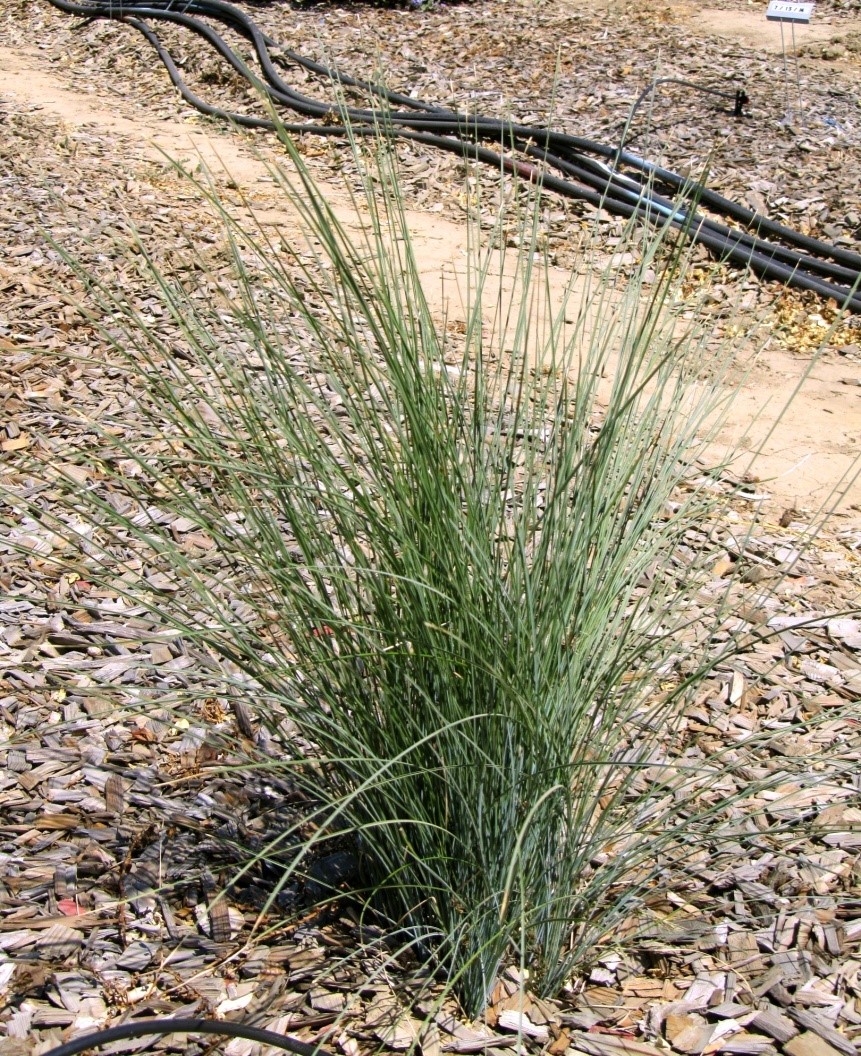Lomandra confertifolia ssp. rubiginosa 'Seascape'

Lomandra ‘Seascape’ on 40% ETo in September 2011. Photo: SK Reid.
Summary
UC Davis is located in Davis, California, this site has a silty clay loam soil and plants are irrigated with potable water. More information about the field sites is located in the Nuts & Bolts section.
Full Sun Results:
Following is a quote from a botanical website in Australia, where this plant is native. “All the Lomandra confertifolia species described grow in dry sclerophyll forest with some shade, except for one type which grows in rocky sandstone type soils. This is probably the reason why most fail in humid type climates, as well as dry climates where it is full sun and heavy soil types (sic)” (which describes our exact conditions). This same source recommended planting out no smaller than 6” pots; the plants we had were 4” pots. Given these characteristics, it is not surprising that this plant did not thrive in the full sun in our clay loam soil. Establishment on regular water was just not sufficient to overcome this plant’s probable preference for partial shade in our hot location.
The only significant differences in growth parameters were between the highest and lowest irrigation levels. Very low water is clearly not recommended for Lomandra. The flowering was probably triggered by a stress survival response. We felt that given the ideal growing conditions, this did have the potential to be an attractive landscape plant for dry shade, though another trial in shade would be needed to confirm that.
50% Shade Results:
As with our other attempts to grow L. confertifolia cultivars, we killed more plants than we were able to keep alive; in this case 8 out of 24 plants survived, roughly evenly distributed between treatments (80% n=3; 50% n=2; 20% n=3). We present the data in the appendix for the survivors, but the sample size was insufficient to determine statistical significance between treatments (Table 20a). Plants that survived never looked robust and healthy in our soil and climate. For this reason, we do not recommend this species/cultivar in this growing region.
Trials staff attempted to select the best-looking individual for each treatment and species before the May Open House for participants to rate throughout the season. However, the individuals of L. ‘Seascape’ selected to represent the 80% and 20% ETo treatments died after the July open house. This is an accurate representation of how the species performed as a whole as discussed in the previous paragraph. It should be mentioned that the individual selected for the 80% ETo treatment was the best specimen in the field, which is why its initial (May) mean and median scores were significantly higher than the other two individuals (Table 20b). Perhaps the best conclusion that could be drawn from looking at this set of Open House data is 1) if a large enough sample size of plant material is grown, at least one individual will look exceptional; 2) if a large enough sample of people rate the plant, at least one individual will think a plant cultivar is exceptional.
Basic Info
| Submitted by: | Ball Ornamentals |
| Site(s): | UC Davis |
| Trial Exposure: | Sun & 50% Shade |
| Year evaluated: | 2011 - Sun 2017 - 50% Shade |
| Height & Width (after 2 years): | 11" x 10" - Sun 14" x 22" - 50% shade |
| Reported Height & Width (at maturity): | 12-24" x 24-36" |
| WUCOLS plant type: | G |
| Water Needs & WUCOLS Region: | High - Region 2 (Sun) |
Mean Overall Appearance rating: (1-5 Scale, 5 is highest) | 3.2 - Sun NR - 50% Shade |
| Flowering Months: | May-July - Sun |
Growth and Quality Data